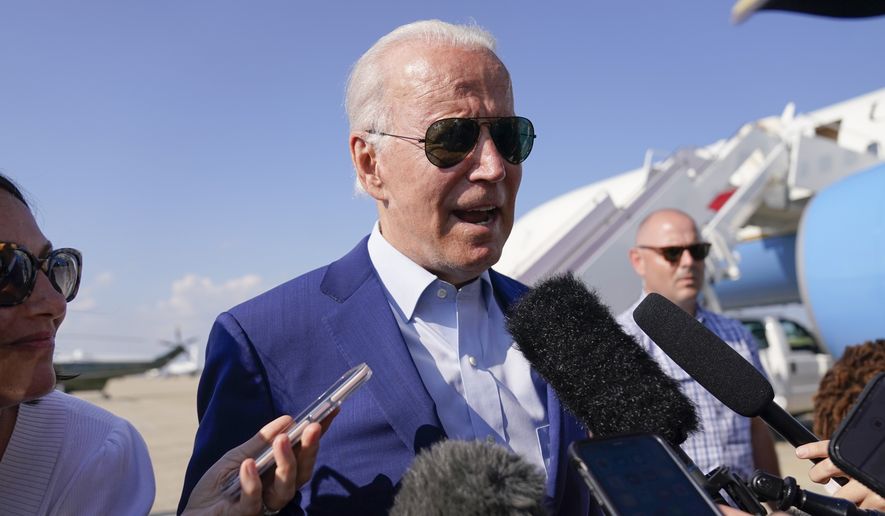The biggest wrinkle in President Biden’s new anti-crime plan is that the same plan didn’t work when former President Clinton tried it nearly 30 years ago.
Unveiled Thursday, Mr. Biden’s Safer America Plan includes spending nearly $13 billion in the next five years to add 100,000 police officers to state and local departments across the country. The funds will be given to municipalities through the Justice Department’s Community Oriented Police Services (COPS) program.
A senior administration official told reporters the plan aims to prevent violent crime by funding officers who will walk the beat and know the neighborhood.
Mr. Biden was expected to lay out the plan at an event Thursday in Wilkes-Barre, Pennsylvania, but the trip was canceled after he tested positive for COVID-19. It is unclear if the event will be rescheduled.
The plan largely mirrors a much-ballyhooed program implemented by Mr. Clinton in 1994. Much like now, America in 1994 was awash in violent crime and gang violence and Mr. Clinton sought to curb it by spending $10 billion in six years to add 100,000 new officers through the COPS program.
However, multiple studies conducted by both the federal government and independent researchers concluded the plan failed to achieve its goals.
Researchers found that the program had a modest impact on crime rates, didn’t reach its hiring goals and the positions that were added got eliminated when the funding ran out in 2000.
“There is no widespread agreement in the research community as to whether police hiring under the 1994 crime bill reduced crime, so there is no reason to expect anything different now,” said John L. Worrall, a criminology professor at the University of Texas-Dallas who has studied the Clinton plan.
A 2005 report from the Government Accountability Office, concluded the funds accounted for “a comparatively small contribution to local law enforcement expenditures.”
SEE ALSO: Hunter Biden probe is reaching critical stage: Report
Although the nation’s overall crime rate declined by 26% between 1993 and 2000, the GAO said the funds to add 100,000 new officers accounted for about 1.3% of the decrease. The GAO concluded that the improved economy under Mr. Clinton did more to lower crime rates than expanding the number of officers through the COPS program.
“Factors other than COPS funds accounted for the majority of the decline in crime during this period,” the GAO said in the report.
Other studies have yielded similar results.
A 2006 research paper by William Evans and Emily G. Owens, two economists at the University of Maryland, found the cost of the program outweighed the benefits.
Mr. Worrall and Tomislav V. Kovandzic, a criminologist formerly at the University of Alabama and now at the University of Texas Dallas, conducted their own study. The results, published in the journal Criminology in 2007, concluded, “COPS spending had little to no effect on crime.”
Oklahoma City, which declined to participate in the COPS program, launched its hiring program in 1994 and saw a similar decrease in crime, according to media reports at the time. The city implemented a local public safety tax that enabled the Oklahoma Police Department to hire 200 officers over several years.
At the time, then-Police Chief William Citty turned down the federal aid because he wouldn’t be able to sustain the new hires once funding ran out in 2000.
Marc Levin, Chief Policy Counsel for the Council on Criminal Justice, an anti-crime think tank, said the limited funding hamstrung the program from bolstering local police forces.
SEE ALSO: Biden to pitch $37 billion anti-crime plan in Pennsylvania amid surging gun violence
“Most jurisdictions were not able to sustain the additions,” he said. “It’s not easy finding good cops and the way the COPS plan was structured, the funding disappeared over time. As cops retired or left the force, those positions weren’t backfilled and it wasn’t a lasting increase.”
A 2000 Justice Department Inspector General report found that many police departments had no plans to retain new officers once their federal funding ran out.
The funding for Mr. Biden’s plan expires in five years, unlike the Clinton plan which paid for the new officers for six years.
Mr. Clinton’s plan also faced widespread criticism because it never reached its hiring goals. The number of officers hired by departments across the country has been debated for years.
The GAO study said the program resulted in 88,000 “sworn officers.” A 2000 study by the National Institute of Justice pegged that number at between 69,000 and 84,000 police officers, a shortfall of between 15% and 31%.
• Jeff Mordock can be reached at jmordock@washingtontimes.com.




Please read our comment policy before commenting.